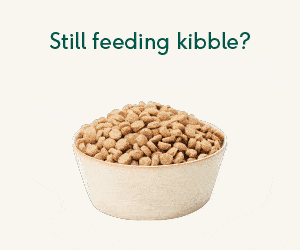
As a kid I often heard every dog year is seven human years, but is that established fact?
Well, no.
Let’s say the average lifespan of a human is 80 years (give or take based on average lifespans of western countries).
We often consider the average lifespan of a dog, again in western countries, as between 10 and 13 years.
If we take the average of that, as 11 and a half years, then one dog year will amount to roughly seven human years.
As a pet nutritionist I would of course pick holes in that. Many holes, in fact, as that average lifespan of a dog is based on most dogs eating a diet which is far from healthy – kibble – and poor quality kibble at that.
That makes me wonder, what would the average lifespan of a dog be if our dogs were fed a truly healthy diet?
Many dogs have lived into their 20s, which would roughly equate to 4 dog years to 1 human year, or in some cases 3 dog years to 1 human year!
Let’s explore this topic a little further, as it may help us realise our dogs could be much healthier if we fed them a better diet!
- What are the maximum lifespans of dogs, and why is this important?
- Why did these dogs live so long?
- What is the average lifespan of a human, and why does it vary per country?
- What is the real average lifespan of a dog?
- What is a true representation of dog years to human years?
- Other considerations which affect how we calculate dog years against human years
What are the maximum lifespans of dogs, and why is this important?
Our first consideration is how long can a dog live for?
The reason this is important, is in relation to humans it can be far longer than what we consider “average”.
Let’s prove that by considering the lifespans of these dogs:
- Bluey, an Australian Cattle Dog. Born in Victoria, Australia, Bluey reached 29 years and 5 months, having spent 20 of those years working on a farm.
- Taffy, a Welsh Collie in the UK, who reportedly lived to 27 years. We don’t know much about his lifestyle, although his age is well-documented.
- Butch, a Beagle in the United States who made the Guinness Book for living 28 years.
- Bramble, a Border Collie in the UK who lived to 25 years. Bramble is a legend amongst the vegan community who often refer to her as “the oldest dog in the world”, as she had a diet reportedly of rice, lentils, and organic vegetables (not that I recommend you feed this to your dog).
- And finally, Adjutant, a Labrador Retriever born in the UK in 1936 (way before mainstream kibble), who lived 27 years and 3 months.
Let’s take the average lifespan of those dogs, approximately 27 years, and multiply it by seven – that would mean a human could live to 189 years!
We know that’s not true! Not yet, anyway!
The question this leave us is this – what is the real average lifespan of a dog?
Or from my viewpoint, what is the real average lifespan of a dog if we fed them properly?
You know most “dog food” is inappropriate processed junk food, right?
Why did these dogs live so long?
As a pet nutritionist I hope you can forgive me for jumping to the conclusion of diet as the reason the above dogs lived so much longer than the average dog.
However, what I found interesting – and I expect you will to – is the diets of these dogs and other dogs who have lived far longer than expected.
Consider the following:
- Bluey – Combined with the physical exercise of living and working on a farm, Bluey’s diet was reportedly locally sourced meat such as kangaroo and beef, supplemented with farm-based scraps.
- Taffy – With little information of Taffy’s diet, it is expect as a working dog his diet was similar to Bluey’s, likely high-quality meat scraps, scraps, and possibly some vegetables.
- Butch – Given the time period, Butch would’ve likely had a diet of fresh meats and home-prepared table scraps, combined with being a typically energetic Beagle.
- Bramble – I confess Bramble as a surprise outlier for me having been fed a vegan diet, but the important point to note is this was an organic homemade diet.
- Adjutant – Again an active breed, Adjuntant lived during a time when processed dog food wasn’t common. His diet, like many dogs of the time, would’ve likely been fresh game meat, offal, bones, and other table scraps.
You may note two interesting factors here – (1) all were active breeds, who likely lived an active life, and (2) none were fed processed dog foods.
To further reinforce this observation, let’s consider a few more:
- Bobi, a Rafeiro do Alentejo in Portugal, who allegedly became the oldest dog ever at 31 years (although this could not be factually proven). Bobi’s owners credited his longevity to a natural diet of human food – farm-fresh produce, human-grade meat, and no processed pet food whatsoever.
- Maggie, a Kelpie in Australia, who lived an unverified 30 years, who reportedly ate a diet of fresh, locally source meat, milk, and vegetables. Like some of the other dogs above, Maggie also had an active life on a farm.
Do you find it interesting none of the above dogs were fed processed kibble, or processed dog food in general?
It makes you wonder why processed pet foods are so heavily endorsed by veterinarians, breeders, and all manner of advertising campaigns as being the best and healthiest option for our pets.
What is the average lifespan of a human, and why does it vary per country?
Let’s consider the other aspect which allows us to gauge how many dog years per human year – the average lifespan of us.
Forgive me for ruling out big parts of the world, but for the sake of simplicity here are some average human lifespans within western countries (source: statisticstimes.com):
- Australia – 84.06 years.
- United Kingdom – 81.45 years.
- United States – 79.46 years.
- Switzerland – 84.09 years.
- France – 83.46 years.
- Monaco – 87.14 years.
From this it’s clear the average person will live to 80+, but it doesn’t take much to realise many factors affect how long we live. Diet and lifestyle are clearly important factors, but also healthcare, infrastructure, environment, sanitation, education, and so much more.
I included Monaco as an interesting one, because I a loose conclusion would be wealthy people have access to better quality foods, better health care, and likely live healthier lives in general.
Healthy food is expensive, right?
Having visited Monaco recently I also discovered local pet shops would stock expensive brands such as ACANA, Orijen, and an ultra-premium German brand Terra Canis which is outstanding despite an eye-watering price tag of $15+ per can based on the price it was selling for!
Without citing scientific journals (I prefer to use common sense rather than the dubious hypotheses which rarely prove what you believe they do), let’s consider the following – Would you think a daily diet of processed food would shorten or lengthen your lifespan compared to a diet of premium healthy foods, meat, and vegetables?
It makes sense, right?
Eat healthy, live longer.
What is the real average lifespan of a dog?
So, what if most dogs are in the “processed food diet” category?
In my experience they generally and undeniably are, and it doesn’t take much in the way of investigation to realise that’s the case.
I watched a movie last week (Canary Black) where a conversation about getting a dog resulted in “they’re easy, they eat kibble”, and another movie (A Man Called Otto) which showed a family feeding their dog birthday cake. These are observations I make all of the time, but can you recall seeing anything on mainstream media where a dog is fed flesh, organs, and bones?
Do you wonder what the average lifespan of dogs would be if they weren’t fed processed pet foods, and were fed real foods made of meat, organs, bones, eggs, fresh veggies, and healthy oils?
Would it still be 10 to 13 years, or would it be much higher?
Keeping in mind most kibble is processed grains, scraping through regulations with the minimum amount of poor quality meat and some powdered form of vitamins and minerals, ask yourself the following:
What if we didn’t have reams of processed kibble concocted from cheap cereal grains and sprinkled with dubious vitamin/mineral powders bought from dubious overseas suppliers?
What is the average lifespan of a dog fed a kibble made mostly of meat compared to one made mostly of artificially preserved and coloured wheat?
What is the average lifespan of a dog fed a nutritious raw food diet of flesh, muscle meat, organs, and bones?
We don’t have clear answers to these questions.
They fall into a grey area as there is little support for “science” such as this. Answers in these areas are often anecdotal and usually observational.
Did you know most research into our pets, and the nutritional needs of dogs and cats, is led and/or funded by pet food companies?
Because of the many unanswered questions, and a scientific black hole because pet food companies have no interest in researching what would negatively impact their profits, I ask you to consider what the real lifespan of a dog could be when fed a truly healthy diet?
10 to 13 years?
15 to 20 years?
Or going by the examples above, perhaps more?
What is a true representation of dog years to human years?
Let’s say we (1) took the average age of a human to be 80 years.
Let’s also say (2) we abolished the pet food aisle and replaced it with whole prey meat, organs, and raw meaty bones (the ultimate wish of my veterinarian friend Dr Tom Lonsdale author of Multi-Billion-Dollar Pet Food Fraud who I have a great deal of respect for).
To offer a different viewpoint on the “7 dog years to 1 human year” assumption, let’s consider the average lifespan of a dog to be higher – 16, 20, or 25 years?
This would give the following dog years to human years conversions:
- 16 years – 5 dog years for every human year.
- 20 years – 4 dog years for every human year.
- 25 years – 3.2 dog years for every human year.
It makes you think, doesn’t it?
Let’s hope true research into feeding our dogs a healthy diet rather than a processed diet can prove what will remain only a theory, but ask yourself – What is the true average lifespan of a dog?, as only then can you determine an accurate calculation of dog years to human years.
Other considerations which affect how we calculate dog years against human years
In this article we’ve looked at dog years to human years as a mere average human lifespan divided by average dog lifespan, but there are factors I purposefully haven’t taken into account.
During the puppy phase, your dog will mature at a faster rate than any human.
To put this simply, a male dog can reach sexual maturity from 6 months. Using the 7 dog years to 1 human years calculation that would mean a male human would be sexually active from 3.5 years. In turn, a female dog can fall pregnant from 6 months as well.
Small dog breeds develop much faster than large dog breeds. Smaller breeds also live longer – a Chihuahua has an average lifespan of 15 to 20 (based on an average kibble diet?), and a Great Dane between 7 to 10 years.
Dogs develop very rapidly in their early years compared to humans who, how do we put this, are a little slower.
That said, dogs reach adulthood earlier, and that rapid initial development tails off. Their aging process slows down.
Humans, on the other hand, have a far more gradual aging process.
Because of these non-linear factors, we often speculate the following timeframes are more accurate:
- First year of a dog’s life = 15 human years.
- Second year = 9 human years.
- Subsequent years = 4-5 human years.
This approach more accurately reflects the life stages of your dog compared to us humans, but let me leave you with the open question – How long could your dog possible live if you feed them a truly healthy diet?
What are your thoughts?







